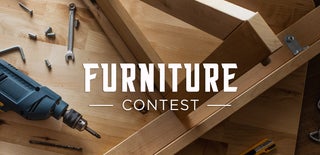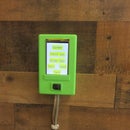Introduction: Movable Shop Tool Ladder
In Every Tool's a Hammer, Adam Savage talks about organizing his workshop. After many years of trying various strategies, he settled on a movable tool ladder. I am setting up a new workshop after moving and this looked like an excellent thing to have. The book has a picture and a note on size, which was enough for me to design my own version.
As a pro, Adam has a lot of tools. He has several ladders - the one shown in the book is devoted just to pliers! I can fit all of my frequently used tools on one. I pretty much copied what I saw in the book, except that I replaced the middle rung with a shelf. I also added a couple of side shelves, a drill holder and couple of containers for files.
After building various workbenches and whatnot, I had several large pieces left from 4'x8' 3/4" plywood sheets, which I used for the body and the middle shelf. I designed the ladder to be useful, sturdy and easy to build with materials I had on hand. In other words, if you crave fine joinery, it might be best to look elsewhere!
I've used my ladder for a couple of months now and find it really useful. One of the most useful projects I've ever done!
I'm entering this Instructable in the Furniture contest. I hope you'll vote for it.
Supplies
Materials:
3/4" plywood cut list:
- one 3'x4' or two 2'x4' pieces for the side (see step 1 for pros and cons)
- one 2'x2' piece for the bottom
- one 1'x2' piece for the top
- one 18 3/4" x 23 1/4" piece for the middle shelf (the length depends on the shelf location)
- one 5"x3.5" piece for the drill holder (optional)
1"x3" common (0.75"x2.5" true) board cut list:
- three 23 1/4" pieces for the rungs
- two 9" pieces for the side shelves (optional)
cut list for the top fence (3/4"x3/4" boards)
- two 10" pieces
- two 23" pieces
one each 5" and 2" pieces of 1"x2" (common) boards for the drill holder (optional)
4 2" caster wheels on swivel mounts
4 #12x3" wood screws (shorter can be substituted, see Step 3)
37 #12x2" wood screws
9 #12x1" wood screws
16 small wood screws for attaching wheels
wood glue
shellac
Tools: (these are the tools I used, you could easily build this with some other equipment)
circular saw
compound miter saw
jigsaw
router
- 3/4" straight bit
drill
drill press
Forstner bits
countersink bit
Step 1: Make the Body
I used a 3'x4' piece of plywood to make the sides and a 3'x2' piece to make the top and bottom.
Cutting a single piece of plywood to make both sides has the advantage of wasting no plywood. However, both sides will have the same orientation when stood up. In my case, the plywood had a slight curve and only one "nice" side. So the ladder also has a slight curve to its sides and one side has "good" side facing outwards, while the other "good" side is facing inwards. If you want your ladder to look better and are not as, ah, "frugal" as I am, you'll get a better result if you use two 2'x4' pieces and cut your sides for the best match.
Based on the tools I wanted to store on the ladder, I decided to have three rungs and a shelf in the middle. The spacing of the rungs is not even - lower rungs are spaced more widely to accommodate longer tools. See the plans below for details - there is the original Inkscape, as well as the PDF.
You can easily change the rung/shelf configuration to fit your tools, but keep in mind that the depth of the shelf will change if you move it to a different location. The shelf is not required structurally, so it can be replaced with a rung if that fits your needs better.
I used my router with a 3/4" straight bit to cut 3/8" inch deep dadoes for the rungs and the shelf. I cut the rung dadoes a smidge too long, so I didn't have to square the edges.
I made a rough cut of side openings with a jigsaw and smoothed it out with a router and a straight bit. A picture shows the fences I clamped to the side so I could just slide the router along.
Step 2: Make the Shelf and the Rungs
I found that 2" spacing works well for the tool holes in ladder rungs. Holes for pliers are 1" while the top rung (for screwdrivers) and the bottom rung (for assorted tools) have holes of different diameters to fit the various tools I planned to keep there.
It's good to dry fit everything before final assembly.
Cut the pieces for the side shelves and make whatever holes needed for what you plan to keep there. I am not using them fully yet. So far, one holds thin screwdrivers, while the other holds assorted drill bits.
Cut the stock for the fence on top.
Step 3: Assembly
Each joint was glued and backed up with screws. The ladder rungs and the middle shelf went first, then top and bottom. Bottom and the middle shelf used 5 screws per side, while the top used 4. Each rung got a screw to on each side to strengthen the joint. I countersunk all the heads.
I had some leftover #12x3" screws, so I screwed in the side shelves from the inside. Shorter screws can be used if you screw the shelves in from the outside.
The fence on top has gaps on each corner, so the top tray is hopefully easier to clean. Each long piece gets two screws, while the short pieces get a screw each.
If you decide to make the optional drill holder, do the next step and come back here.
I put on two coats of shellac to finish the ladder.
Finally, a wheel goes on each corner.
Step 4: Optional Drill Holder
I didn't want things hanging on the outside of the ladder, but it turned to be a really good spot for my drill. I used a 5"x3.5" piece of a 3/4" plywood, with the slot cut to fit my drill - see the dimensions in the attached plan. I beveled the slot 15 degrees from vertical to make it fit better.
Connect the two short pieces of 1"x2" together and mount them onto the side of the ladder. The screw connecting the pieces is invisible once they're mounted. Mount the holder on top.
A sharp eyed reader will notice that I added the holder after the fact - it hadn't been shellaced yet when I took the photos.
Step 5: Finishing Touches
Depending on the tools you have, there may be plenty of things you can add to your finished ladder. I mounted a piece of PVC pipe on the back to hold a set of small files and a Wet Wipes container on the back of the shelf for my large files. I currently keep my socket wrenches on the shelf (I haven't needed to put any holes for tools in it yet) and the top holds a mess of driver bits, drill bits, rulers, markers and assorted chaos. Bottom shelf currently holds just my Dremel in a classy cardboard box - I was heartily sick of shoehorning it back into its case every time!

Participated in the
Furniture Contest













